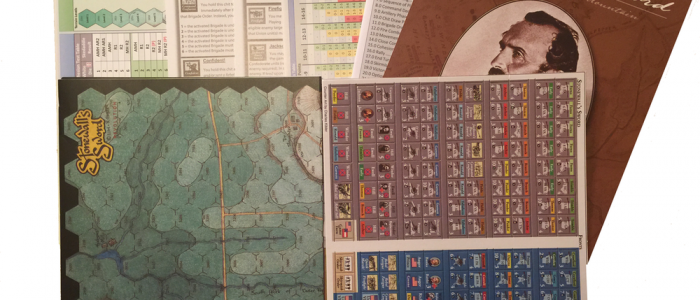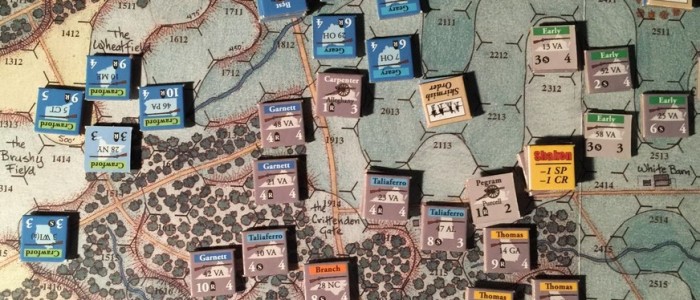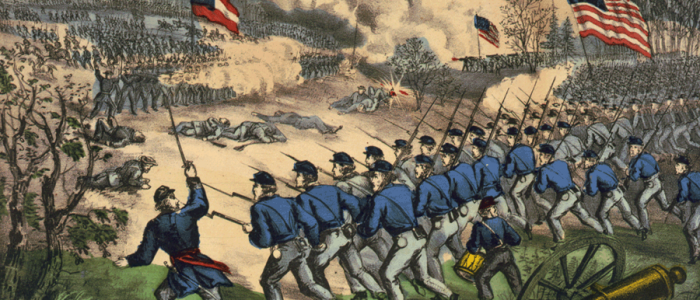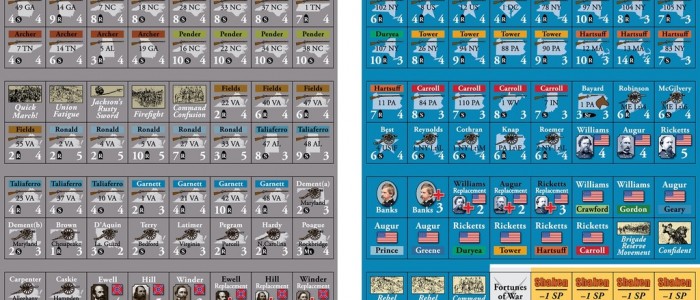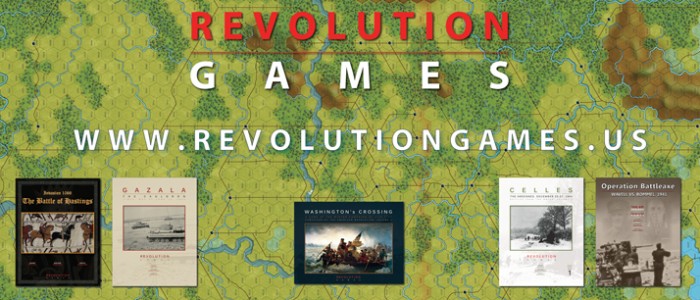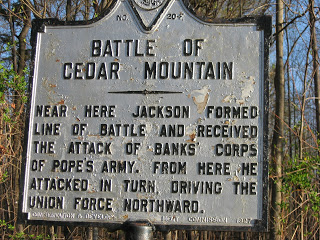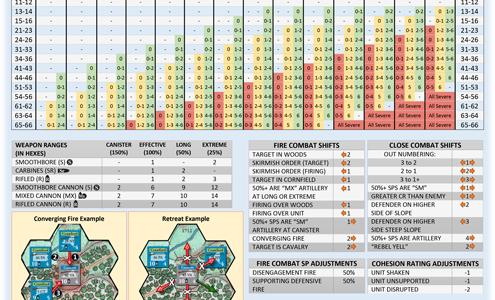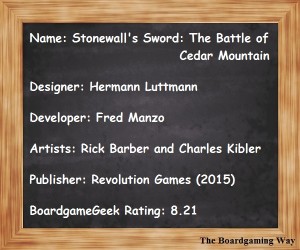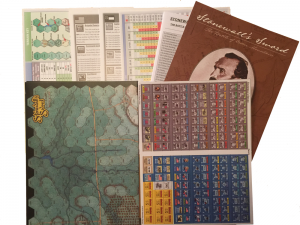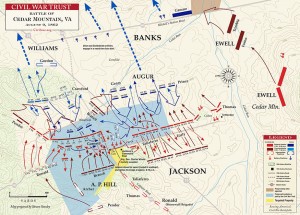Stonewall's Sword
By Mitch Freedman:
conflict disclosure –
There may be a conflict in my reviewing this game, although I personally see no reason not to do so as long as people are aware of it. Actually, there may be two. Or four. I leave that up to you.
I know Fred Manzo, and I know Herman Luttmann. I like them both. And, I have played games with them, more than once. Both are involved in FatDog, the Fall wargaming convention on Long Island that has been a steady and enjoyable part of my life for several years.
Fred’s gaming markers are always more neatly arranged than Hermann’s. They are more neatly arranged than any other player I know. Both are involved in creating this game.
The Civil War is also my favorite period for wargaming. There are good arguments to be made that it had more impact on America and the world today than any other conflict. But, that’s a story for another day.
I see no reason not to share my objective opinion about this game, which – if I were doing a movie review – I would call innovative, crisp, complex and challenging. Or maybe a must-have Summer Blockbuster. Well, maybe not that last one. That would be the nose of the conflict of interest camel, sneaking in under the Union tent.
Lets just say that when you open the package, get ready to be sucked into the Civil War.
See if you agree with me. — Mitch
 Stonewall’s Sword recreates the Battle of Cedar Mountain, the first significant clash between the Army of Northern Virginia and John Pope’s new Army of Virginia. Marked by several lapses in leadership, the 1862 battle starts out with the Union gaining an early success with an audacious attack, only to see a reversal as Confederate reinforcements arrive, ending with a successful counter-attack by A.P. Hill.
Stonewall’s Sword recreates the Battle of Cedar Mountain, the first significant clash between the Army of Northern Virginia and John Pope’s new Army of Virginia. Marked by several lapses in leadership, the 1862 battle starts out with the Union gaining an early success with an audacious attack, only to see a reversal as Confederate reinforcements arrive, ending with a successful counter-attack by A.P. Hill.
It is the only battle in which Stonewall Jackson was reported to have drawn his sword, to stir the morale of his left flank, which was on the verge of collapse. It is also the battle where Clara Barton actually cared for the wounded on the battlefield itself.
The Confederates outnumbered the Union troops by about 16,000 to 8,000, according to the Civil War Trust. But, like the actual battle, Confederate reinforcements in this game dribble in slowly, with Hill arriving almost too late to save the day.
The struggle has been called a badly-managed fight on both sides. But the game rules – which sets out to recreate the uncertainties of battle and the sometimes random results of combat – might have you thinking a bit more kindly toward the commanders. By the end of the game, you might even wonder how anyone could ever manage a Civil War army.
That is Stonewall’s Sword’s goal, and that is its success. But, sometimes, getting what you wish for is not getting what you expected. And, players will get a real workout before reaching the game’s climax.
Fair warning – this is not a game where you can simply calculate the odds, roll a couple of dice, and get a decisive battle result.
Stonewall’s Sword mixes in enough uncertainty so that neither side can plan and reliably execute an optimum attack. There is a lot of chance factored into a system that is driven by chit pulls. Heck, sometimes you will not even be able to attack, because your enemy holds a chit that stops you from doing it.
So, just like a real Civil War battle, the commanders won’t really know which of their units will be charge when ordered, or may find another unit being moved into danger by their opponent. Damn orders were just misunderstood!
On top of that, it uses a shoot first, then move system. That means attackers trying to close with the enemy will likely get shot at before they can come into contact with the enemy. And, with supporting fire from artillery, it can get bloody for attackers very quickly.
But the door is also open to grand maneuvers, at least until you get to really close range. Effectiveness of artillery drops off sharply beyond a couple of hexes, and trees and a wheat field provide excellent cover, so sweeping moves are a tempting option.
Fair warning two – The game has two scenarios, and each gives both armies victory points for every enemy strength point forced onto the broken unit track (shot up past the point of being an effective combat unit) at the end of the game. There are also victory points for control of certain hexes, although this Confederates only get points once, and only if they are the last unit in their victory hexes. The Union gets points for every turn they control their victory hexes.
You might find it helpful to put markers on the victory hexes, since in the heat of battle its easy to forget you need to occupy them. It helped me.
In some ways, Stonewall’s Sword plays more like a metal miniatures battle than a board game. That’s because its played on an attractive map showing a small part of Culpepper County, Virginia, one that uses 10 separate colors to mark the terrain as it changes from hills to open ground to a river valley, with lines showing steep changes in elevation and some man-made features – think victory objectives – also drawn in.
When you first set up the game, you can almost see a 3-D map. Confederate units in the introductory scenario stand on the high ground, while the Union troops line up behind each other along the roads and in the woods.
Troops have to use the roads to get into the battle, and clogging up a road when you have a lot of soldiers and artillery to get from one place to another can become a real problem.
The initial set-up in for the introductory scenario – its called Valley Vengeance – has the bulk of the Union forces coming up from a river valley – one flank is coming through the woods – to attack a Confederate position.
At least some Union troops will have to cross an open area and lose the protection of cover, but as the slope changes some of the trees will start blocking vision, making them harder – but not impossible – to hit.
When you really start to see the changing contours and the important of the few roads, you will be getting deep into the game. And, once you start pulling chits and realize that not all your troops will go where you want them to (even with a neat little device that gives you a really good chance to move one unit of your choice), you start feeling what the officers may well have faced. No more simply dismissing a bad result as “poor leadership.” Unless, of course, it really is poor.
More about those chits later. Its important.
Just as the map is different from most other board game battle maps, the combat results resolution is really different as well. In most games, I roll the dice, look at a chart and read the results.
These battle charts go into overdrive.
Hitting units can cause damage, but hits can also create problems by forcing morale checks in what the game calls “unit cohesion.” And, units don’t just lose morale and break. There are different levels of disruption and breaking.
The game rules pile on even more. Units have a chance to come back, as some troops get over the shock of combat and stragglers who initially fled come back and join the fight again.
You don’t just roll your two six-sided dice and get a combat result of 2 to 12. They are different colors, with one die representing the tens column. So, a roll of 1 and 1 is read as 11, while a role of 6 and 3 is read as 63. A lot more possible outcomes.
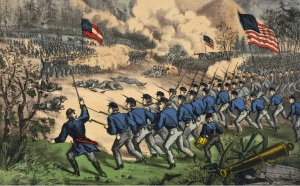 Those results have different effects on troops, and the impact of an attack can be severe. Generally, the stronger the attackers, the more damage they do. But extreme range can cut the strength of a firing unit by three-quarters, and firing over woods or other cover leads to column shifts on the combat results table.
Those results have different effects on troops, and the impact of an attack can be severe. Generally, the stronger the attackers, the more damage they do. But extreme range can cut the strength of a firing unit by three-quarters, and firing over woods or other cover leads to column shifts on the combat results table.
Which leads to one more observation. Combat in this game tends to be more realistic than in most others I have played. And, that observation needs a bit of definition.
Realism, in a game, is an oxymoron. There is no blood in the box or on the map. Never will be. You don’t feel the sharp terror that an artillery barrage can produce, and you don’t wince as the cardboard counter next to you is hit by overlapping fire from different hexes.
Still, there is an odd thing about close combat in Stonewall’s Sword. Most units will suffer some kind of morale loss as troops are hit and melt away, but sometimes the spines of the survivors stiffen and a unit will fight on well past the point where it might be expected to break.
 That’s where the elegant, multi-color combat results table and the two tables on the other side – the fire combat cohesion test table and the close combat cohesion test table – come in.
That’s where the elegant, multi-color combat results table and the two tables on the other side – the fire combat cohesion test table and the close combat cohesion test table – come in.
I call them elegant because even a lone unit at long range has a chance to shoot at an enemy and force a morale test. (The combat results table simply shows you which of three charts to use – routine, tough or severe. Close combat has a fourth chart as well). But, some will stand and fight hard when losses mount.
Compared to most games where a hit flips a counter over or destroys it, these charts allow some enemy hits to cascade down to other units in a hex, or to force a retreat. The combat cohesion test can lead to a loss of morale, and units that break will find themselves off the board, awaiting orders to recover. And, those orders may come too late to have any impact on the game, or may never come at all.
Which leads to one yet another special feature of this game – the chits.
There are a couple of drivers to this game. One big one is the command chits, which allow you to give one of four different instructions to each of your brigades, one at a time as they are randomly pulled.
You can attack, which lets you shoot and engage enemy units in close combat, but gives you just four movement points. You can maneuver with six movement points, but not engage the enemy. You can defend (2 movement points) which allows troops to rally, but at a handicap. Or, you can regroup, making it easier to rally but eliminating any chance to shoot at the enemy.
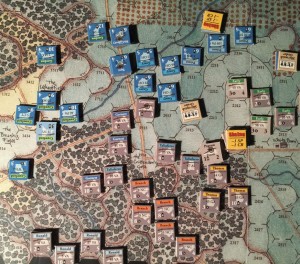 The random pulling of order chits also leads to a “fog of war” uncertainty, because brigade command chits aren’t the only things that go into the hat to be pulled at random. Each side also has several chits which can help them move or attack, hamper the enemy or protect against an enemy chit that can hurt their side. Both sides get to pick chits to put into the hat each turn. But, diabolically, not every chit is put into the hat each turn, so opposing players never quite know which ones will turn up., you won’t get to really see how the machinery of the game work
The random pulling of order chits also leads to a “fog of war” uncertainty, because brigade command chits aren’t the only things that go into the hat to be pulled at random. Each side also has several chits which can help them move or attack, hamper the enemy or protect against an enemy chit that can hurt their side. Both sides get to pick chits to put into the hat each turn. But, diabolically, not every chit is put into the hat each turn, so opposing players never quite know which ones will turn up., you won’t get to really see how the machinery of the game work
Now, all of this may seem a bit confusing. If so, I will take at least some of the blame. I decided to write what I think are the most interesting things about this game at the top of this review, while talking about the move-to-move mechanics at the end.
While its fun for me to look at the special aspects of Stonewall’s Swords until you actually move some counters around the board and go through the mechanics of giving commands.
It will likely take a couple of tries before you get comfortable. Just how long should you press an attack with a shot-up unit? Can you afford to stay on defense and shoot back, or do you regroup?
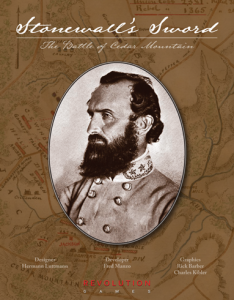 This is not a game for novices, and its certainly shouldn’t be the first Civil War board game you play. But, if you have seen the Union and the Confederate troops clash over and over again and still yearn to create the chaos and glory of battle, this game does it better than most others.
This is not a game for novices, and its certainly shouldn’t be the first Civil War board game you play. But, if you have seen the Union and the Confederate troops clash over and over again and still yearn to create the chaos and glory of battle, this game does it better than most others.
As the overall commander of one side or the other, you know where you want your troops to be, how you want to attack or defend, and when to take advantage of the enemy’s weakness or disorder.
Stonewall’s Sword comes alive in showing just how hard it is to make your individual brigades move where you want them to, and how to actually support an attack when an advantage is presenting itself. Or to watch your troops run to the rear, or – even worse – move into open ground in front of the enemy’s artillery.
It makes every turn an adventure. Whether that qualifies as realistic, I leave it up to you to decide.
Game Resources:
 Stonewall’s Sword Rules (PDF)
Stonewall’s Sword Rules (PDF)
Stonewall’s Sword Map Player’s Aid
Vassal Module for Stonewall’s Sword



